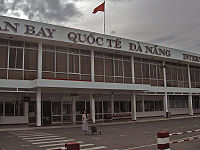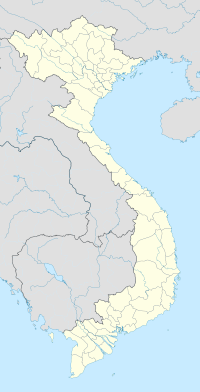- Da Nang International Airport
-
Da Nang International Airport
Sân bay Quốc tế Đà Nẵng
IATA: DAD – ICAO: VVDN Location of airport in Vietnam Summary Airport type Public / Military Operator Central Airports Authority Serves Da Nang Elevation AMSL 33 ft / 10 m Coordinates 16°02′38″N 108°11′58″E / 16.04389°N 108.19944°E Runways Direction Length Surface ft m 17L/35R 10,000 3,048 Asphalt 17R/35L 10,000 3,048 Asphalt Da Nang International Airport (IATA: DAD, ICAO: VVDN) (Vietnamese: Sân bay Quốc tế Đà Nẵng) is located in Da Nang, the largest city in central Vietnam. It is the third international airport in the country, besides Noi Bai International Airport (Hanoi) and Tan Son Nhat International Airport (Ho Chi Minh City), and is an important gateway to access central Vietnam.
In addition to its civil aviation, the runway is shared with the Vietnamese People's Air Force (VPAF, the Không Quân Nhân Dân Việt Nam), although military activities are now extremely limited.[1]
Contents
History
Situated on flat, sandy ground on the south side of the major port city of Da Nang, the area was ideal for an airfield, having unobstructed approaches to its north/south runways. Tourane Airport was built by the French colonial government in the 1930s as a civilian airport. During World War II, and the Japanese occupation of French Indochina, the Imperial Japanese Army Air Force used it as a military air base.
 B-26C Serial 44-34109 of the French Air Force over Indochina, 1952. This aircraft was returned to the USAF Oct 1955 and scrapped.
B-26C Serial 44-34109 of the French Air Force over Indochina, 1952. This aircraft was returned to the USAF Oct 1955 and scrapped.
After the war, the facility was used by the French Air Force during the French Indochina War (1945–1954). In 1953/54 the French laid a NATO-standard 7,800-foot (2,400 m) asphalt runway at Tourane and stationed loaned American B-26s "Invaders" of the Groupe de Bombardement 1/19 Gascogne. In 1954 after the Geneva Peace Accords, these B-26's were returned to the United States.
In 1955, the newly-established Republic of Vietnam Air Force (VNAF) inherited from the French a token force of fifty-eight aircraft. These included a few squadrons of Cessna L-19 observation aircraft, C-47 transports and various utility aircraft. Tourane Airfiled was turned over to civilian use, with the South Vietnamese using facilities at Bien Hoa, Nha Trang and at Tan Son Nhut, near Saigon.
In 1957 the VNAF re-established a presence at the renamed Da Nang Airport, stationing the 1st Liaison Squadron with Cessna L-19s. The South Vietnamese Army (ARVN) also used Da Nang as a ranger training facility.
Air Vietnam also used the facility from 1951 to 1975 for civilian domestic and international flights within Southeast Asia.
During the Vietnam War (1959–1975), the facility was known as Da Nang Air Base, and was a major United States military base. Once little more than a provincial airfield, the facility was expanded to 2,350 acres (950 ha) with two 10,000-foot (3,048 m) asphalt runways with concrete touchdown pads. parallel taxiways, and a heliport.
Recent history
During the year 2006, Da Nang Airport counted one million passengers annually (40,000 international passengers), the first time since 1975 it had reached this level.[1] By comparison, both the fourth-ranked Phu Bai Airport and fifth-ranked Cam Ranh Airport counted around 400,000 total passengers in the same year.[citation needed]
Airlines and destinations
Current regular flights serving Da Nang International Airport are as follows:
Airlines Destinations AirAsia Kuala Lumpur [begins 16 December 2011] China Eastern Airlines Charter: Beijing-Capital, Chengdu, Kunming [all ends 1 December] Far Eastern Air Transport Charter: Taipei-Taoyuan Jetstar Pacific Airlines Ho Chi Minh City Shanghai Airlines Shanghai-Pudong SilkAir Siem Reap, Singapore TransAsia Airways Charter: Taipei-Taoyuan Vietnam Airlines Buon Ma Thuot, Da Lat, Hanoi, Hai Phong, Ho Chi Minh City, Nha Trang, Pleiku
Charter: Taipei-Taoyuan, Tokyo-NaritaPacific Airlines inaugurated its daily flight between Da Nang and Hanoi in November 2005, giving domestic passengers an additional choice when flying between Da Nang and the capital, a route that had long been monopolized by Vietnam Airlines. At the beginning of 2008, Korean Air and Asiana Airlines announced the operation of summer charters between Seoul (Incheon International Airport) and Da Nang. Both carriers plan to convert this route to year-round regular scheduled service if this summer charter season proves to be successful.
TransAsia Airways started service between Taipei and Da Nang in December 2009 [charter], and China Southern Airlines began service between Guangzhou and Da Nang in January 2010[2]; flights operate twice weekly. The Vietnamese Government is hoping to serve more flights, to destinations such as Phnom Penh, Hong Kong, Siem Reap, Japan, South Korea and Thailand after the construction of the new international terminal is complete in 2011.
Statistics
Busiest Domestic Flights Out of Da Nang International Airport by Frequency Rank Destinations Frequency (Weekly) 1 Ho Chi Minh City 104 2 Hanoi 56 3 Nha Trang 14 4 Buon Ma Thuot 7 4 Da Lat 7 4 Pleiku 7 7 Hai Phong 4 Accidents and incidents
- On 30 September 1970, Douglas DC-3DST B-305 of Air Vietnam crashed into a hill near Da Nang while attempting to divert to Da Nang Airport due to weather conditions at its intended destination of Phu Bai Airport, Huế. Three of the 38 people on board were killed.[3]
Facilities
Da Nang International Airport has two 10,000-foot (3,048 m) paved, parallel runways (17-35 orientation) capable of handling large, modern aircraft such as Boeing 747s, 767s and Airbus 320s.[1] Traffic volume at Da Nang averages 100 to 150 flights every 24 hours. Annual traffic was circa 1.45 million in 2007 and is expected to reach four million by 2020.[4]
A feasibility study for the renovation of the airport was partially sponsored by the United States Trade and Development Agency (USTDA), and was completed by PriceWaterhouseCoopers in 2006. A new 20,000m² terminal, priced at USD $84 million with a capacity of 4 million passengers per year, is scheduled for completion at the end of 2011. The new terminal will include five boarding gates, baggage handling systems, departure and arrivals areas, flight information display system (FIDS), common user terminal equipment (CUTE), fire detection systems and comprehensive public address and security systems, including screening equipment. Additionally, one of the airport's two runways will be extended from 3,048 metres (10,000 ft) to 3,500 metres (11,483 ft).[1] Once this project is completed—after a total investment of USD $160 million—the airport will have a total capacity of six million passengers per year.[1][5]
See also
References
- ^ a b c d e "Danang International Airport, Vietnam". Airport-technology.com. http://www.airport-technology.com/projects/danang/. Retrieved 2010-05-13.
- ^ Guangzhou-Da Nang flight to be launched on Jan. 15
- ^ "B-305 Accident description". Aviation Safety Network. http://aviation-safety.net/database/record.php?id=19700930-0. Retrieved 20 October 2010.
- ^ "Xây nhà ga mới ở sân bay Đà Nẵng". Thời báo kinh tế Sài Gòn online. 2007-12-24. http://mobile.thesaigontimes.vn/ArticleDetail.aspx?id=1829. Retrieved 23 tháng 4 năm 2008.
- ^ Expansion of Da Nang International Airport, (Vietnamese)
Further reading
- Mikesh, Robert C. (2005) Flying Dragons: The South Vietnamese Air Force. Schiffer Publishing, Ltd. ISBN 0764321587 (Historical origins of the facility)
External links
- Infrastructure in Danang
- Airport information for VVDN at World Aero Data. Data current as of October 2006.Source: DAFIF.
- Airport information for DAD / VVDN at Great Circle Mapper. Source: DAFIF (effective Oct. 2006).
- Accident history for DAD / VVDN at Aviation Safety Network
- Current weather for VVDN at NOAA/NWS
 Airports in Vietnam
Airports in VietnamInternational Domestic Planned International: Ho Chi Minh City-Long Thanh · Phu Quoc-Phu Quoc International · Quang Ninh
Domestic: Lang Son · Thanh Hoa · An GiangNo civil use Bac Giang · Bien Hoa · Cao Bang · Da Lat-Cam Ly · Hai Phong-Kien An · Hanoi-Bach Mai · Hanoi-Gia Lam · Categories:- Airports in Vietnam
- Da Nang
Wikimedia Foundation. 2010.
Look at other dictionaries:
Noi Bai International Airport — Sân bay Quốc tế Nội Bài Noi Bai International Airport IATA: HAN – ICAO: VVNB … Wikipedia
Can Tho International Airport — Sân bay Quốc tế Cần Thơ IATA: VCA – ICAO: VVCT … Wikipedia
Tra Noc International Airport — Infobox Airport name = Trà Nóc International Airport nativename = nativename a = nativename r = image width = caption = IATA = VCA ICAO = VVCT type = owner = operator = Southern Airports Authority city served = location = Can Tho elevation f = 9… … Wikipedia
Tan Son Nhat International Airport — Infobox Airport name = Tan Son Nhat International Airport nativename = Cảng Hàng không Quốc tế Tân Sơn Nhất image width = 240 IATA = SGN ICAO = VVTS type = Public owner = Vietnamese government operator = Southern Airports Corporation city served … Wikipedia
Lien Khuong International Airport — Sân bay Quốc tế Liên Khương IATA: DLI – ICAO: VVDL … Wikipedia
Cat Bi International Airport — Sân bay Quốc tế Cát Bi IATA: HPH – ICAO: VVCI … Wikipedia
Taiwan Taoyuan International Airport — 臺灣桃園國際機場 桃園機場 IATA … Wikipedia
Shanghai Pudong International Airport — 上海浦东国际机场 Shànghǎi Pǔdōng Guójì Jīchǎng Logo of Shanghai Airport Authority … Wikipedia
Guangzhou Baiyun International Airport — 广州白云国际机场 Guǎngzhōu Báiyún Guójì Jīchǎng … Wikipedia
Chengdu Shuangliu International Airport — 成都双流国际机场 Chéngdū Shuāngliú Guójì Jīchǎng IATA: CTU – ICAO: ZUUU … Wikipedia


